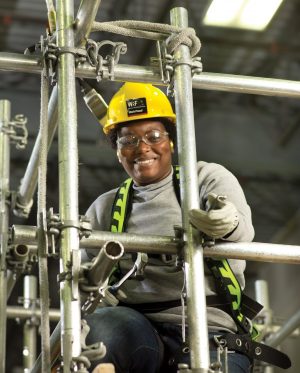Ontario’s lien act reform, impending marijuana legalization, Trump talks and the sale of a construction industry giant were just some of the issues that graced the front page of the Daily Commercial News in 2017, in what would be a year of change and adaptation. Here is a breakdown of our Top 10 newsmakers.
Ontario has a new Construction Act
Long-awaited lien act reform became official in 2017 after years of extensive review, consultation and modification.
In December, it was announced that Bill 142, the Construction Lien Amendment Act, 2017, had reached royal assent. Ontario now has a new Construction Act — albeit there is still work to be done as regulations will need to be developed under the new law, a process that is slated to start in the new year.
The lien act amendments are in response to the report Striking the Balance: Expert Review of Ontario’s Construction Lien Act, authored by construction lawyers Bruce Reynolds and Sharon Vogel and delivered on April 30, 2016. They were commissioned to conduct the review in February 2015.
The three main elements of the reform package are the modernization of the Construction Lien Act, the introduction of prompt payment rules and the establishment of an adjudication mechanism that provides an interim binding resolution of disputes in order to solve them faster.
Construction industry stakeholders had long sought-after lien act modernization, with several associations and groups lobbying government officials for change. Throughout 2017, as more information rolled out on the review, associations, law firms and the like held various events to better inform the industry on what the changes mean and how stakeholders will be impacted.

Construction industry prepares for the legalization of marijuana
The Trudeau government announced plans in 2017 to legalize marijuana by July 1, 2018, which left many in the construction industry uncertain about how best to prepare worksites for this new world.
Throughout the year, many national and provincial conferences held forums, panel discussions and symposiums about how best to deal with weed in the workplace.
The Canadian Construction Association hosted a session on the topic during its 99th annual conference in Mexico; the Ontario General Contractors Association hosted a session during its symposium and co-hosted a Cannabis in Construction event with the Residential Construction Council of Ontario; the Vancouver Regional Construction Association’s leadership forum addressed Weed at Work: Risk for Employers; and Construct Canada held a session billed Cannabis on Job Sites: Legal Insights of Upcoming Legislation. This names but a few of the events and discussions that took place and were featured in the Daily Commercial News and Journal of Commerce throughout the year.
Stakeholders also lobbied the federal government directly on the matter as well as in their respective provinces. While the outcome of the legalization remains to be seen, those in the industry all agreed safety needs to take priority above all else.
Construction monopoly, real or imagined?
The construction employer designation of municipalities, does it result in a construction monopoly for certain industry signatories? Is it an open tendering issue? Or, is it an anti-union issue?
It all depends where on the construction landscape you have staked your place in the ground. But one thing is for sure, for yet another year, the issue has beleaguered some municipalities and mobilized various stakeholders in construction.
Sault Ste. Marie proved to be ground zero for this debate in 2017. Its city council has set the wheels in motion to change its construction employer status after careful deliberation. Sault Ste. Marie has been designated a construction employer for 30 years and states it has taken its first steps in changing this status because it is an “open/closed tendering issue” and not a union/anti-union issue Mayor Christian Provenzano told the Daily Commercial News in December. The city has directed staff to make the necessary adjustments to its budgeting and activities in 2018 in order for it to approach 2019 differently and then “potentially successfully challenge the designation,” added Provenzano.
Industry divided on OCOT initiatives
Early on in 2017, then Ontario College of Trades (OCOT) chair Pat Blackwood made the statement the College had pressed the reset button and was ready to achieve the goals it set out when it launched in 2013.
He made that comment just as the College was about to draft regulations to implement amendments to the Ontario College of Trades and Apprenticeship Act (OCTAA) approved by the Ontario legislature in December 2016. The College at the time was seeking feedback on four topics: journeyperson to apprenticeship ratios, compliance and enforcement policy, trade classification reviews and a program evaluation process. The consultation “road show” that took place was described by Blackwood as a success, with industry in support of the College’s goals.
His comments received backlash from stakeholders, who were quick to point out there was still a long way to go before the industry was in total support of the College’s endeavours.
Major differences between Ontario’s compulsory and non-compulsory trades was evident but appeared to have been resolved to some extent after Minister of Labour Kevin Flynn held four days of meetings at the end of March and early April.
When OCOT released its long-anticipated Compliance and Enforcement Policy in May, it was clear issues still lingered on a variety of fronts with many in the industry feeling as if it wasn’t clear or fulsome enough.
In September, the industry applauded the announcement that Ontario’s former chief prevention officer George Gritziotis would become the new registrar and CEO of OCOT.
However, in December it was announced that the International Brotherhood of Electrical Workers Construction Council of Ontario, the Ontario Pipe Trades Council and the Electrical Contractors Association of Ontario had launched a legal challenge asking the court to uphold sections of the OCTAA that “requires complex trade work be performed by trained and certified individuals.”
Health and safety still at the forefront in 2017
Health and safety initiatives didn’t take a backseat in 2017, despite all the other news that was making waves.
Several announcements occurred throughout the year, with significant headway being made when it came to the Certificate of Recognition (COR) program, the League of Champions and other health and safety endeavours.
One highlight occurred in March when the City of Brampton not only adopted the COR program as part of its construction contract management and tendering process, but also looked at getting certified itself.
Staying along that same line, Infrastructure Ontario announced companies looking to work with the agency on larger direct delivery construction projects will only be able to participate in the request for qualifications process if they have applied for the COR certification program. COR has continued to gain momentum since its inception.
The League of Champions also continues to grow with more members joining on in 2017 and putting their signature on the Jersey of Courage.
The Ontario General Contractors Association announced it is launching a new safety tool for all general contractors, subtrade associations and industry leaders who want to reduce training time and costs through one cohesive online health and safety orientation program, which will continue to take shape in 2018.
And in December it was announced that the provincial government is evaluating the effectiveness of its mandatory Working at Heights training standards.
Canada Infrastructure Bank takes shape
The new Canada Infrastructure Bank (CIB) raised a lot of discussion among construction industry stakeholders in 2017. The $35-billion bank plans to leverage public funds to attract private investment for infrastructure projects.
Some critics have claimed the way the CIB is structured currently lacks transparency. Supporters of the CIB are anxious for it to open its doors and funding till. In July, retired financial executive Janice Fukakusa was appointed as the CIB’s first-ever chair.
In June, the federal infrastructure ministry suggested the CIB may consider investing in Montreal’s $5.3-billion automated LRT project. Interestingly, in July, it was reported that Washington State is exploring whether Canada’s new infrastructure bank could help finance a multibillion-dollar proposal for high-speed rail between Vancouver and the U.S. northwest.

Buy America, NAFTA dominate Trump talks
U.S. President Donald Trump’s “buy America” agenda has government and construction leaders across the border watching and waiting, speculating on what his next move will be.
During several industry events in 2017, guest speakers, including analysts and well-known journalists, provided intel on what could happen in Canada when it came to matters such as the North American Free Trade Agreement (NAFTA), as Trump threatened to “blow up” the agreement with Canada and Mexico.
Pulitzer Prize-winning journalist Carl Bernstein, the keynote speaker at the CanaData East conference in Toronto in September, said Trump is holding power in a “malignant presidency” that has metastasized and added Trump is guilty of “systematic lying.” He said despite Trump’s “almost purposeful ignorance and unwillingness to do the hard work,” there is a chance he will back down from the protectionist measures he has been promising.
In mid-December, NAFTA negotiators halted discussions for the holidays, planning to reconvene in the new year.
Federal prompt payment gains momentum
With all eyes on Ontario as its construction lien act reform moved from concept to reality in 2017, the issue of prompt payment has become entrenched in a piece of provincial legislation. As this unfurled in 2017, at the federal level, lobbying and proposed legislation for federal prompt payment legislation continued to gain momentum. The Canadian senate unanimously passed Bill S-244, the Canada Prompt Payment Act, in May 2017, regulating payments on federal construction contracts. The bill now faces the scrutiny of the House of Commons.
Both Public Services and Procurement Canada and Defence Construction Canada launched their own prompt payment websites explaining their “prompt payment principles.” They are also developing a tool to post on a public website the dates on which they issue payments to their prime contractors on construction contracts above $100,000.
Canadian construction giant Aecon sold
In October, Chinese company CCCC International Holding Ltd. (CCCI) inked a deal to buy Aecon Group — valued at $1.5 billion. CCCI is the overseas investment and financing arm of China Communications Construction Company Ltd., one of the world’s largest engineering and construction groups. Aecon will continue to be headquartered in Canada.
Aecon received two regulatory permissions in December which were needed for it to be sold to CCCI. The deal does still faces a review under the Investment Canada Act. Aecon shareholders overwhelmingly approved the purchase in a Dec. 19 vote. Aecon has worked on Canadian landmarks including the CN Tower, Vancouver’s SkyTrain and the Halifax Shipyard.
Analysts reported in September, when it was announced Aecon was for sale, that the 140-year-old firm’s value had taken a hit thanks to the downturn in commodities impacting energy and mining projects.

Trying to bridge the expected labour shortage gap
There are certain axioms in life one can count on and they are death and taxes.
When it comes to the construction industry, its projected labour shortage is one stakeholders can count on. Diversification and retention of the industry’s labour pool were major themes this year.
BuildForce Canada stressed with impending retirements and an increase in labour demands ramping up, the need to connect women with careers in the trades is critical. Currently, women make up about 12 per cent of the construction workforce with the majority working off site. At the Provincial Building and Construction Trades Council of Ontario convention this year diversification of the trades was its overarching theme. Social media platform LinkedIn issued its first-ever Toronto Workforce Report in 2017 and concluded construction-related skills are among the most needed in the Greater Toronto Area.











Recent Comments
comments for this post are closed